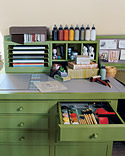 Local is an important thing to many people, not just to the businesses but also to the consumer. I remember when I was a young girl growing up in Windsor, Ontario and going to ‘town’ with my grandma… the little downtown and the “five & dime” shops. I remember the ‘big’ store downtown where grandma use to do a lot of the domestic shopping… it had a little cafe in there that we would always get a bite to eat… my favorite- french fries and gravy, yeah that’s a Canadian thing! Well anyway, I use to love to go to the little hardware store that she would by her canning jars and lids at, the Chinese food restaurant that we would patronize on grandpa’s pay day… memories of a small town… a lot of children in today’s society won’t know that as a regular experience. It will more likely be a ‘vacation’ memory. So many of us want to know who grew those tomatoes, or who raised that sheep to produce the fiber that made those lovely mittens, or shake the hand with the farmer that milked that cow that you now can get fresh raw milk from. It is a good feeling to ‘know your farmer’… it is good feeling to talk to Mary when you purchase that jar of cherry preserves she made… it is rewarding to hand your hard earned money over to a person that worked hard to provide you with something essential. It is a win-win situation for all involved.
Local is an important thing to many people, not just to the businesses but also to the consumer. I remember when I was a young girl growing up in Windsor, Ontario and going to ‘town’ with my grandma… the little downtown and the “five & dime” shops. I remember the ‘big’ store downtown where grandma use to do a lot of the domestic shopping… it had a little cafe in there that we would always get a bite to eat… my favorite- french fries and gravy, yeah that’s a Canadian thing! Well anyway, I use to love to go to the little hardware store that she would by her canning jars and lids at, the Chinese food restaurant that we would patronize on grandpa’s pay day… memories of a small town… a lot of children in today’s society won’t know that as a regular experience. It will more likely be a ‘vacation’ memory. So many of us want to know who grew those tomatoes, or who raised that sheep to produce the fiber that made those lovely mittens, or shake the hand with the farmer that milked that cow that you now can get fresh raw milk from. It is a good feeling to ‘know your farmer’… it is good feeling to talk to Mary when you purchase that jar of cherry preserves she made… it is rewarding to hand your hard earned money over to a person that worked hard to provide you with something essential. It is a win-win situation for all involved.
Many small towns of today have the big bad ‘W’ store along with others that have killed the mom & pop shops. It’s so sad really, but we can help keep things local by just doing a few small things: Shop in town, close to town and at least within your own state. Local by most definitions allows a 100 mile radius from your home- that gives you a lot of options if you think about it! Many of us are going to make New Years resolutions tomorrow… let at least one be to make a conscious effort to support your local community this year!
 I thought it would be interesting to put some tips on how to buy local, support local and live local!
I thought it would be interesting to put some tips on how to buy local, support local and live local!~Buy direct from the producer as often as possible. By doing this you can recompense them fairly for their work. The best way to do this is to shop as locally as you can! Find locally owned businesses in your area, go to the Farmers Market, check sites like Local Harvest, Local Dirt and Slow Food for producers around you!
~Join a CSA. Shares of seasonally grown vegetables, fruit, meat & eggs, dairy can be sent directly to your door or picked up at local Farmers Markets or area businesses. Emphasis is always on local & fresh.
~Shop your local Farmers Markets. There are gobs of Summer and Winter farmers markets all around. They not only provide you with a great selection of local products, you get to meet the producers first hand.
~Shop small specialty shops. These independent shops provide a more pleasurable shopping experience than the big box stores or super markets could ever offer. They will even want to learn your first name!
~When you dine out, eat at a local restaurant that buys at least some of their menu ingredients from local producers/resources. You’ll be surprised at how many restaurants are doing this.
 There are ton’s of great Local minded groups out there that are great resources for all of us- again both producer and consumer. One that has a really good mission is the 3/50 Project http://www.the350project.net
There are ton’s of great Local minded groups out there that are great resources for all of us- again both producer and consumer. One that has a really good mission is the 3/50 Project http://www.the350project.netThey encourage us to think of three businesses you’d hate to see disappear, pop in and say hello once a month; the goal is to spend $50 between those three businesses. That really is not a lot when you look at where you spend your money in a month.
 • To promote and strengthen independent brick and mortar businesses owned by people in the community
• To promote and strengthen independent brick and mortar businesses owned by people in the community
• To thank consumers for their patronage
• To expand local revenue streams by showing how a small dollar amount can translate into enormous financial stability
• To shine a light on the stark contrast between what an independent, locally owned brick and mortar business contributes to the local economy versus the significantly lower amount big boxes, franchises, chains, and internet purchases return
• To save the local economy…three businesses at a time
Be sure to check out their Facebook and website for lots more details I don’t have time to put here.
 Other great Local Resources:~Edible WOW Magazine: This is one of the best resources out there for Southwest Michigan www.ediblewow.com
Other great Local Resources:~Edible WOW Magazine: This is one of the best resources out there for Southwest Michigan www.ediblewow.com ~Edible Communities: web site to direct you to an Edible publication in your area www.ediblecommunities.com
~Local Harvest: list of producers in every state www.localharvest.org
~Google Farmers Markets to find local ones in your area
~Local Dirt: listing for producers www.localdirt.com
There are gobs more out there and thanks to the internet you can find just about anything you want LOCALLY!
Sweet Onion and Sausage Spaghetti
6 oz uncooked Spaghetti
3/4 pound Italian Sausage Links, casings removed
2 tsp Olive Oil
1 sweet onion, thinly sliced
1 pint cherry tomatoes, halved
1/2 c loosely packed fresh basil leaves, chopped
1/2 c half & half cream
Shaved Parmesan cheese, optional
Cook spaghetti according to package directions.
Meanwhile, in a large nonstick skillet over med. Heat, cook sausage in oil for 5 minutes. Add onion; cook 8-10 min.s longer or until meat is no longer pink and onion is tender.
Stir in tomatoes & basil; heat through. Add ream; bring to a boil. Drain spaghetti; toss with sausage mix. Garnish with cheese if desired.
 Baked Onion Cheese Dip
Baked Onion Cheese Dip 2 c shredded cheddar cheese
1 c shredded pepper Jack cheese
1/4 c cream cheese, cubed
1/2 c mayonnaise
1/4 tsp fresh thyme
2 c chopped sweet onions, divided
Assorted crackers
1. in a food processor, combine the cheeses, mayo, thyme & 1 c onions; cover 7 process until blended. Stir in remaining onions.
Transfer to a greased 3 c baking dish. Baked, uncovered at 375 degrees for 20 –25 minutes or until bubbly. Serve with crackers.
Tuscan Soup
4 cups chicken broth
1/2 cup heavy cream
3 medium potatoes
1 ob. Spicy Italian Sausage
1/2 tsp. salt
1/2 tsp. crushed red pepper flakes
3 cups chopped kale
Brown Sausage; cool.
Combine the broth and cream in a sauce pan; slice the unpeeled potato into 1/4 inch slices; add the browned sausage; add the kale.
Add the spices and let soup simmer for about 2 hours. Stir occasionally.
Happy Day,
Jean



















